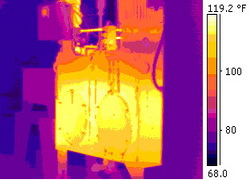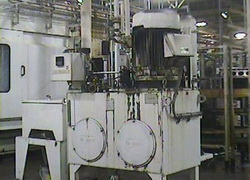
-
Application Stories
• Building
• Furnace and Boiler Tube Inspection
• Medical
IR Trouble Shooting on Hydraulic Systems
The predictive technology team at DMAX, Ltd. consists of a mechanical technician and an electrical technician. We primarily use the IR camera to run predictive routes on electrical panels, buss plugs, and motors. Occasionally, we are called to the plant floor to help troubleshoot a problem. This paper discusses a trouble call on a hydraulic system that supports one of our larger machines.
DMAX, Ltd. builds the Duramax Diesel engine for use in General Motors heavy duty trucks. At our facility the engine block, head, crank, and connecting rod are machined. These parts are used in our assembly area where we build and test the engine. The problem occurred on a cylinder block line transfer machine that is 54' x 30' consisting of 5 cutting stations, 2 rotate stations, a gage station, check station and 5 idle stations. Most of the cutting stations have a left and right side. Each cutting station either bores, chamfers, or mills the cylinder block. After each station finishes a cycle, the machine then transfers the cylinder block to the next station. Hydraulic cylinders are used to transfer the blocks as well as rotate them and clamp the part when it is being machined. Hydraulic cylinders are also used in several stations to assist the large cutting heads as they rise and lower. This hydraulic system has a 600 liter reservoir of hydraulic fluid. The OEM has stated that the maximum system temperature should be no higher than 120°F (49°C) when running at a normal pressure of 1200 psig. The system has a high temperature fault that is set at 117°F (47°C). The OEM used yellow zinc dichromate heavy walled steel tubing to distribute the hydraulic fluid to the desired components on the machine. There are several supply and return lines running to each station as well as to the large cylinders used to transfer the blocks as they are machined.
Electricians from the cylinder block line had been called to this operation numerous times to reset high temperature faults on the hydraulic system. The electricians asked the mechanics to check the system for any abnormalities. All pressures and flows were found to be within OEM specification. The electricians also wanted to verify that the actual temperature in the hydraulic system matched the thermal couple reading. We checked the temperature using our FLIR P65 and determined that the thermal couples where operating correctly (Fig. 1). The electricians did not want to spend their day resetting temperature faults. We needed a solution
NFPA 70B recommends that building owners complete IR surveys annually. CNA (and other sources) recommend every 3 to 5 years, depending on level of faults found. The cost of an infrared survey is estimated by CNA at $2,000 per day. CNA performs IR surveys with FLIR P65 infrared cameras. The surveys are conducted at no extra charge to clients who qualify for an offer of an IR survey, saving them at least $2,000 annually.
The risk of blackouts and brownouts are increasing on the US power distribution grid due to its aging infrastructure, and a lack of automation systems that monitor the condition of critical equipment at substations and elsewhere on the grid. For example, transformer fluid leaks or internal insulation breakdown cause overheating that leads to failures, but many utilities don't have automated thermal detection systems that reveal these problems. In addition, the remote locations of many substations make them vulnerable to security breaches, which can be detected with automated infrared imaging systems.
Whatever the cause, a critical substation failure may cascade into series of failures. Indeed, aging substation infrastructure exacerbated the Northeast blackout of 2003, the largest in US history. The result was a massive failure of regional banking facilities, security systems, manufacturing plants, food refrigeration, communication networks, and traffic control systems. Of course, the electric utilities involved lost huge amounts of revenue and incurred enormous costs in getting their systems up and running again. The economic impact is thought to have exceeded $6 billion in the region.


Figure 1. Thermogram/photo pair showing hydraulic system
- Home
- |
- Products
- |
- Training
- |
- Application |
- Image Gallery |
- Contact Us
Copyright ©2012 - Thermoscan Co., Ltd. - All Rights Reserved.
Thermoscan Co., Ltd. (บริษัท เทอร์โมสแกน จำกัด)
731 PM Tower, 5th Floor, Asok Dindaeng Road, Dindaeng, Dindaeng, Bangkok 10400
Tel: (02) 642-9489 Fax: (02) 642-9424
E-mail: tms@thermoscan.co.th
